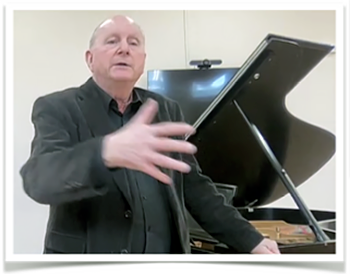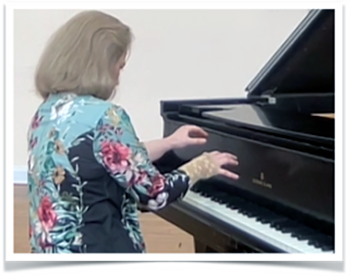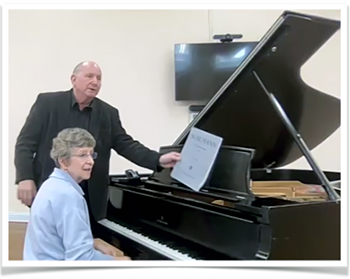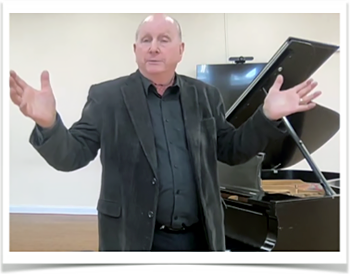Music Educators Association of New Jersey
Serving teachers and students since 1927



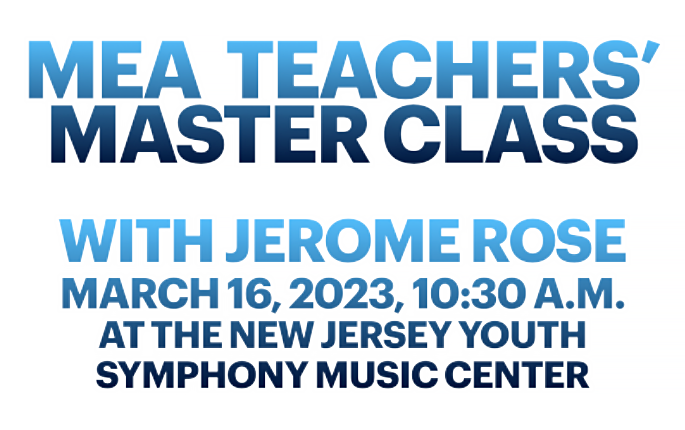
Attendees were handed a beautiful and informative program designed and written by Past President Beverly Shea, coordinator of the master class. President Danette Whelan’s opening remarks at this first 2023 actual/virtual meeting at the NJYS venue were followed by Beverly’s introduction of stellar master teacher Jerome Rose. “Hailed as the Last Romantic of our own age, he has performed in major concert halls across five continents.” In addition, he has conducted numerous master classes in Europe, Asia, and America. He has an extensive discography. Jerome Rose is founder and director of the annual International Keyboard Institute and Festival held in New York. His biography, dating from before Mannes College and Juilliard School undergraduate and graduate studies, to Fulbright Scholar days, his incredible career, and his State University of New York Honorary Doctorate in Music, can be read at: jeromerose.com.
Jerome Rose reminded us of the tradition of tutelage that connected new musicians to the old. The teachers of pre-World War II musicians were connected to the music teachers of the 19th century. A number of virtuosi were cultivated on the West Coast. Among them were Yehudi Menuhin, Leon Fleisher, and Isaac Stern. Post World War II, Jerome Rose at age 15 debuted with the San Francisco Symphony. Now he would coach MEA member pianists.
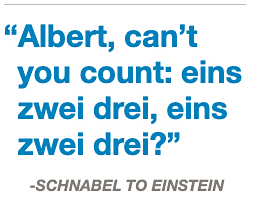 Early in the session, Jerome Rose told the following anecdote: “One day, Albert Einstein was playing a Mozart violin and piano sonata with his friend Artur Schnabel, the famous pianist. Einstein slipped up. Schnabel snapped. Down came the keylid (fallboard), ‘Albert,’ Schnabel pleaded, ‘can’t you count: eins zwei drei, eins zwei drei?’”
Early in the session, Jerome Rose told the following anecdote: “One day, Albert Einstein was playing a Mozart violin and piano sonata with his friend Artur Schnabel, the famous pianist. Einstein slipped up. Schnabel snapped. Down came the keylid (fallboard), ‘Albert,’ Schnabel pleaded, ‘can’t you count: eins zwei drei, eins zwei drei?’”
This anecdote was the harbinger of the leitmotif of Mr. Rose’s main message: RHYTHM!
Jacqueline Schiller-Audi performed Chaconne in G Major, HWV 435, by George Frideric Handel.
Jerome Rose commented: “A very fine performance. How do you perform a harpsichord piece on the piano? Chopin probably was the best at playing Bach as a pianist! There is that ugly staccato that some pianists apply to Baroque keyboard works. Not you. You did very well. You also added your own ornamentation to many spots. Please explain your decisions.”
Jacqueline responded: “I love Bach, so when I first heard this Handel on the radio, I loved it and chose to learn it. I decided when and where to introduce ornamentation; the slower and more melodic variations could carry some, particularly in the repeats.” The ornamentation lent authenticity to her interpretation: Baroque style was applied to her piano playing without resorting to the ugly, pseudo-harpsichord staccato touch.
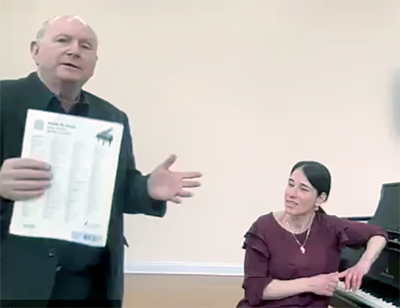 Jerome Rose suggested imagining sitting at an ornate piano, a formal setting for a formal piece. The steady rhythm contributes to the unity of the piece. “A steady beginning is essential. In the chaconne, count three beats in strict time; that rhythm binds the chaconne and 21 variations together. Count out loud.” He counted and conducted as Jacqueline played the opening bars. What is most essential? The harmony, the colors, the textures? “Rhythm is the mortar that holds these bricks together,” holds these he emphasized. As he coached Jacqueline, he added: “The teacher must lead the student to believe [or have confidence] in his/her interpretation. Simplicity is a good trait for a good performance."
Jerome Rose suggested imagining sitting at an ornate piano, a formal setting for a formal piece. The steady rhythm contributes to the unity of the piece. “A steady beginning is essential. In the chaconne, count three beats in strict time; that rhythm binds the chaconne and 21 variations together. Count out loud.” He counted and conducted as Jacqueline played the opening bars. What is most essential? The harmony, the colors, the textures? “Rhythm is the mortar that holds these bricks together,” holds these he emphasized. As he coached Jacqueline, he added: “The teacher must lead the student to believe [or have confidence] in his/her interpretation. Simplicity is a good trait for a good performance."
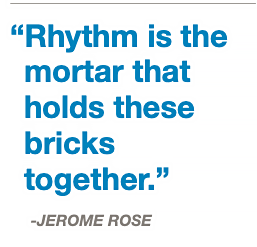 He turned to Variation Nine, in g minor, to listen to Jacqueline’s beautiful ornamentation again, and commented, “Hear the opera in this. It is full of pathos from this great composer of operas.” We heard how a Baroque masterpiece may be played in Baroque style on the piano.
He turned to Variation Nine, in g minor, to listen to Jacqueline’s beautiful ornamentation again, and commented, “Hear the opera in this. It is full of pathos from this great composer of operas.” We heard how a Baroque masterpiece may be played in Baroque style on the piano.
Blanca Ugelli performed Kreisleriana, Op.16, by Robert Schumann
Blanca played the first two of the Kreisleriana. “Very good, but give it some gas. Give it some South American drive,” Jerome Rose urged the Argentinian pianist. In her second playing there was greater contrast between the spirited opening and the pianissimo section beginning in m.25. “I knew you could do it. Much better!” he exclaimed. “I knew how beautifully you can play when I heard you warming up.”
 The second Kreisleriana begins with an expressive, melodious segment where tenor and treble voices move in parallel motion at the tenth, then inner voices move in parallel motion at the third or sixth, and finally in contrary motion. Then Intermezzo I, Molto vivace bursts forth followed by the return of the opening passages. The dramatic Intermezzo II follows with a thick texture, bass and treble “conversing” in imitative dialogue, leading to the final segment, the second repetition of the opening bars.
The second Kreisleriana begins with an expressive, melodious segment where tenor and treble voices move in parallel motion at the tenth, then inner voices move in parallel motion at the third or sixth, and finally in contrary motion. Then Intermezzo I, Molto vivace bursts forth followed by the return of the opening passages. The dramatic Intermezzo II follows with a thick texture, bass and treble “conversing” in imitative dialogue, leading to the final segment, the second repetition of the opening bars.
Jerome Rose emphatically asked Blanca to play hands together. He stressed this. “Schumann tells us when a chord [or dyad] is to be rolled.” (See mm. 25-27.) The first intermezzo should be played with firmer fingers to insure that the two-note slurs are clear. “You have the energy,” he encouraged. Referring to mm. 56 and 58, the first reiteration of the opening section, Jerome Rose approvingly commented, “You played the sforzando as indicated! So many pianists do not execute the dynamic markings, which are different from the opening bars.”
Blanca then treated us to her performance of the third Kreisleriana. Time constraints did not permit further discussion.
Luba Vasilyeva performed Sonata No. 3 in F minor, Op. 5, 1. Allegro Maestoso by Johannes Brahms
This exuberant sonata was written when Brahms was twenty years old. It traverses the keyboard, demanding lightning-speed arm movements to arrive at distant keys in perfect rhythm. It also requires good tone in the espressivo passages, something that Luba did so well.
Well, Jerome Rose had said that accurate rhythm is the mortar that holds a piece together, and his observation was that this performance lacked mortar. He said, “You have great feeling for this piece, but you need more rhythmic discipline.” He sat at the keyboard and demonstrated the thundering opening. “Maestoso means majestic. It will be fine if you play at your tempo; just play it in time,” he insisted. Luba then maintained a steady, slower tempo. Brava! It sounded wonderful.
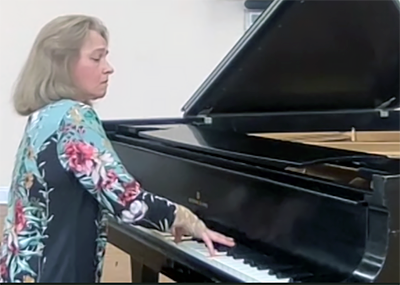 “At mm. 72-74, following the repeat bar, maintain the rhythm. When the opening motif returns at the maestoso at m.109, again maintain that rhythm.” The master teacher counted energetically. Arriving at fest und bestimmt (m. 135), he explained that it meant strong and determined. Those words described Luba as she worked to integrate the various sections of this movement. Jerome Rose praised her. “Just think how more beautifully you performed just by counting and playing in correct rhythm.” We applauded enthusiastically.
“At mm. 72-74, following the repeat bar, maintain the rhythm. When the opening motif returns at the maestoso at m.109, again maintain that rhythm.” The master teacher counted energetically. Arriving at fest und bestimmt (m. 135), he explained that it meant strong and determined. Those words described Luba as she worked to integrate the various sections of this movement. Jerome Rose praised her. “Just think how more beautifully you performed just by counting and playing in correct rhythm.” We applauded enthusiastically.
A short Q & A session followed. New metronomes available on our devices were discussed, but Jerome Rose would use a metronome mainly to check tempo. To maintain a tempo, count out loud! Of course there will be places for rubato. “We do not wish to sound like robots.”
Jerome Rose offered these closing thoughts:
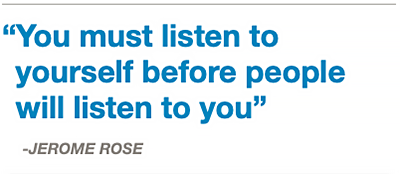 “You must listen to yourself before people will listen to you. Consider nuances, details, refinements, and orchestration of voices. Go with your instinct. Does it feel natural? And listen. Self-criticism is the highest form of masochism. I record my playing to evaluate it. My wife is my [ultimate] critic. And of course, I count!”
“You must listen to yourself before people will listen to you. Consider nuances, details, refinements, and orchestration of voices. Go with your instinct. Does it feel natural? And listen. Self-criticism is the highest form of masochism. I record my playing to evaluate it. My wife is my [ultimate] critic. And of course, I count!”
The meeting at the Music Center was actually attended by 25 people and virtually attended via Zoom by 20. Kudos to Programs Chair Sophia Agranovich and Website Chair Lisa Gonzalez.
Bertha Mandel, writer
Charlene Step, Photographer
Lisa Gonzalez, layout and screenshots
